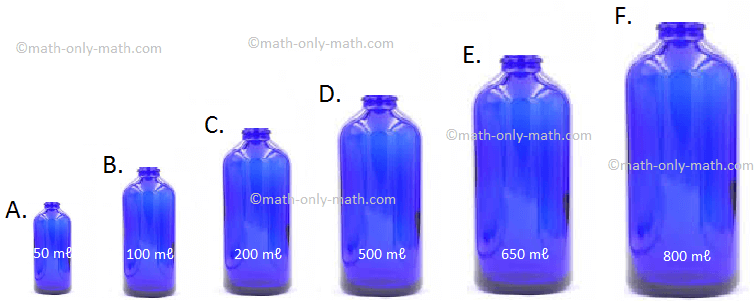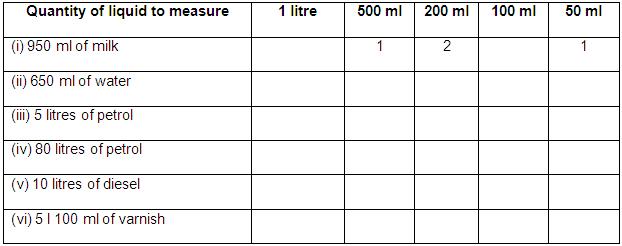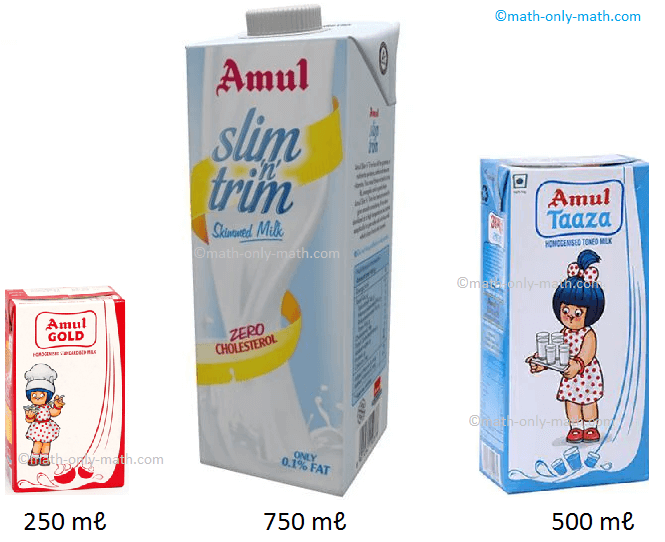Subscribe to our ▶️ YouTube channel 🔴 for the latest videos, updates, and tips.
Worksheet on Measurement of Capacity
In worksheet on measurement of capacity, all grade students can practice the questions on units for measuring capacity. This exercise sheet on measurements can be practiced by the students to get more ideas to learn to measure the capacity of the given line segments according to the questions.
1. Which kind of measure (litre or millilitre) would you use to measure the following things (liquids)?
(i) Milk in a glass
(ii) Medicine in a tea-spoon
(iii) Ink in your pen
(iv) Cough syrup in a bottle
(v) Petrol in a car tank
(vi) Water in a can
(vii) Kerosene oil in a jar
(viii) Paint in a drum
2. Given below are 6 bottles with different capacities. Use 2 or 3 different bottle combinations to form the given quantities.
(i) 1 l 500 ml
(ii) 750 ml
(iii) 1100 ml
Answers:
2. (i) 3 times D
(ii) B + E
(iii) B + C + F
3. What measures will you use to measure the following quantities of given liquid? Write the answer in front of each liquid:
4. A car can travel a distance of 15 km distance with one liter of petrol. How much distance will the car be able to cover if there is:
(i) 10 l of petrol
(ii) 15 l of petrol
(iii) 20 l of petrol
(iv) 25 l of petrol
(v) 50 l of petrol
(vi) 100 l of petrol
Answers:
4. (i) 150 km
(ii) 225 km
(iii) 300 km
(iv) 375 km
(v) 750 km
(vi) 1500 km
5. How many 200 ml measures of water will fill a:
(i) 1 litre can?
(ii) 4 litre drum?
(iii) 2 litre can?
(iv) 1 litre 400 ml vessel?
6. In a super market different flavors of milk are available. Look at the picture and answer the following questions.
(i) Which container holds the greatest amount of milk?
(ii) What is the total amount of milk in all the containers?
(iii) How much container B holds more than A?
Answers:
6. (i) B
(ii) 1 l 500 ml
(iii) 500 ml
7. A jar contains 1200 ml of milk. How many litres and ml of milk is in the jar?
8. How many 100 ml measures of oil will fill the following vessels?
(i) 200 ml of capacity
(ii) 500 ml of capacity
(iii) 700 ml of capacity
(iv) 1 l of capacity
9. Fill in the blanks:
(i) 1 liter = …………….. ml
(ii) 250 ml × …………….. = 2 liters
(iii) 4 bottles of 750 ml will make …………….. liter.
(iv) If 200 ml water is taken out from 1 l 500 ml bottle. How much water will be left in the bottle?
Answers:
9. (i) 1000 ml
(ii) 8
(iii) 3
(iv) 1 l 300 ml
10. Change the following into ml:
(i) 3 l
(ii) 2 l 75 ml
(iii) 5 l 390 ml
11. Convert into ℓ
(i) 9942 mℓ
(ii) 5642 mℓ
(iii) 7250 mℓ
(iv) 8653 mℓ
(v) 9243 mℓ
(vi) 4250 mℓ
(vii) 3295 mℓ
(viii) 1292 mℓ
(ix) 2453 mℓ
(x) 5249 mℓ
Answer:
11. (i) 9 ℓ 942 mℓ
(ii) 5 ℓ 642 mℓ
(iii) 7 ℓ 250 mℓ
(iv) 8 ℓ 653 mℓ
(v) 9 ℓ 243 mℓ
(vi) 4 ℓ 250 mℓ
(vii) 3 ℓ 295 mℓ
(viii) 1 ℓ 292 mℓ
(ix) 2 ℓ 453 mℓ
(x) 5 ℓ 249 mℓ
12. Convert into kℓ and ℓ:
(i) 7692 ℓ
(ii) 8015 ℓ
(iii) 9005 ℓ
(iv) 8004 ℓ
(v) 4534 ℓ
(vi) 2465 ℓ
(vii) 9008 ℓ
(viii) 1720 ℓ
(ix) 2450 ℓ
(x) 5745 ℓ
Answer:
12. (i) 7 kℓ 692 ℓ
(ii) 8 kℓ 15 ℓ
(iii) 9 kℓ 5 ℓ
(iv) 8 kℓ 4 ℓ
(v) 4 kℓ 534 ℓ
(vi) 2 kℓ 465 ℓ
(vii) 9 kℓ 8 ℓ
(viii) 1 kℓ 720 ℓ
(ix) 2 kℓ 450 ℓ
(x) 5 kℓ 745 ℓ
13. Change the following into liters and ml:
(i) 4000 ml
(ii) 65035 ml
(iii) 32570 ml
14. Do the given conversions:
(i) 36 l = …………….. ml
(ii) 104 l = …………….. ml
(iii) 1258 ml = …………….. l …………….. ml
(iv) 3090 ml = …………….. l …………….. ml
(v) 66192 ml = …………….. l …………….. ml
Answers:
14. (i) 36000 ml
(ii) 104000 ml
(iii) 1 l 258 ml
(iv) 3 l 90 ml
(v) 66 l 192 ml
15. There was 5 l 500 ml of milk in my house. In the evening there was only 2 l 750 ml of milk left. How much milk was consumed during the day?
16. A petrol pump had 15900 litres of petrol in stock. During the day 5,950 litres were sold. How much petrol was left?
17. There is the following quantity of water in three vessels:
(i) 54 l 80 ml
(ii) 67 l 384 ml and
(iii) 56 l 156 ml
Find the total quantity of water.
18. Perform the given operations:
(i) Add 305 l 116 ml and 28 l 65 ml
(ii) Subtract 56 l 203 ml from 75 l
(iii) Add 24 l 206 ml, 36 l 196 ml and 51 l 337 ml
(iv) Multiply 45 l 990 ml by 3
(v) Divide 56 l by 250
Answers:
18. (i) 333 l 181 ml
(ii) 18 l 797 ml
(iii) 111 l 739 ml
(iv) 137 l 970 ml
(v) 224 ml
19. A bucket holds 25 litre of water. 17 litres 250 ml of it was taken out and then 3 litre 780 ml was poured in it. How much water is there in the bucket now?
20. I have 2 l jar filled with milk. If I take out 1 l 115 ml of milk in the morning and 605 ml in the evening then how much milk will be left in the jar?
Answer: 280 ml
21. A bottle has the capacity to contain 250 ml. How much oil can be filled in 20 such bottles?
22. Ana has a water tank with a capacity of 570 l. She fills it completely on Monday. If she uses about95 l of water each day then how many days can tank water last?
Answer: 6 days
23. Among 40 students, 20 litres of juice was distributed. How much juice did each student get?
24. The capacity of a drum is 200 litres. It contains 123 litres of water. How much more water is required to fill it?
25. Out of 350 litres of kerosene oil, 125 l 50 ml was sold. How much is left now?
If students have any queries regarding the questions given in the worksheet on measurement of capacity, please fill-up the comment box below so that we can help you.
However, suggestions for further improvement, from all quarters would be greatly appreciated.
● Measurement - Worksheets
Worksheet on Measurement of Length.
Worksheet on Perimeter of a Figure.
Worksheet on Measurement of Mass or Weight.
Worksheet on Measurement of Capacity.
Worksheet on Measurement of Time.
Worksheet on Antemeridian and Postmeridian.
Worksheet on Interpreting a Calendar.
4th Grade Math Worksheets
From Worksheet on Measurement of Capacity to HOME PAGE
Didn't find what you were looking for? Or want to know more information about Math Only Math. Use this Google Search to find what you need.





New! Comments
Have your say about what you just read! Leave me a comment in the box below. Ask a Question or Answer a Question.